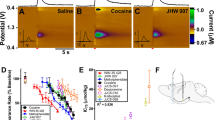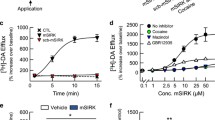Abstract
Drugs of abuse share the ability to enhance dopaminergic neurotransmission in the dorsal and ventral striatum. The action of dopamine is modulated by additional neurotransmitters, including glutamate, serotonin and adenosine. All these neurotransmitters regulate the phosphorylation state of Dopaminal serine/threonine protein phosphatase, PP-1. Phosphorylatine- and cAMP-regulated phosphoprotein, Mr 32 kDa (DARPP-32). Phosphorylation at Thr34 by protein kinase A converts DARPP-32 into a potent inhibitor of the multifunctioon at Thr75 by Cdk5 converts DARPP-32 into an inhibitor of protein kinase A. The state of phosphorylation of DARPP-32 at Thr34 also depends on the phosphorylation state of Ser97 and Ser130, which are phosphorylated by CK2 and CK1, respectively. By virtue of regulation of these 4 phosphorylation sites, and through its ability to modulate the activity of PP-1 and protein kinase A, DARPP-32 plays a key role in integrating a variety of biochemical, electrophysiological, and behavioral responses controlled by dopamine and other neurotransmitters. Importantly, there is now alarge body of evidence that supports a key role for DARPP-32-dependent signaling in mediating the actions of multiple drugs of abuse including cocaine, amphetamine, nicotine, caffeine, LSD, PCP, ethanol and morphine.
Similar content being viewed by others
References
Walaas SI, Aswad DW, Greengard P. A dopamine- and cyclic AMP-regulated phosphoprotein enriched in dopamine-innervated brain regions.Nature. 1983;301:69–71.
Hemmings HC Jr, Greengard P, Tung HY, Cohen P. DARPP-32, a dopamine-regulated neuronal phosphoprotein, is a potent inhibitor of protein phosphatase-1.Nature. Aug 9–15, 1984;310(5977):503–505.
Ouimet CC, Langley-Gullion KC, Greengard P. Quantitative immunocytochemistry of DARPP-32-expressing neurons in the rat caudatoputamen.Brain Res. 1998;808:8–12.
da Cruz e Silva EF, Fox CA, Ouimet CC, Gustafson E, Watson SJ, Greengard P. Differential expression of protein phosphatase 1 isoforms in mammalian brain.J Neurosci. 1995;15:3375–3389.
Girault JA Jr, Hemmings HC Jr, Williams KR, Nairn AC, Greengard P. Phosphorylation of DARPP-32, a dopamine- and cAMP-regulated phosphoprotein, by casein kinase II.J Biol Chem. 1989;264:21748–21759.
Desouits F, Cohen D, Nairn AC, Greengard P, Girault JA. Phosphorylation of DARPP-32, a dopamine- and cAMP-regulated phosphoprotein, by casein kinase I in vitro and in vivo.J Biol Chem. 1995;270:8772–8778.
Desdouits F, Siciliano JC, Greengard P, Girault JA. Dopamine- and cAMP-regulated phosphoprotein DARPP-32: phosphorylation of Ser-137 by casein kinase I inhibits dephosphorylation of Thr-34 by calcineurin.Proc Natl Acad Sci USA. 1995;92:2682–2685.
Bibb JA, Snyder GL, Nishi A, et al. Phosphorylation of DARPP-32 by Cdk5 modulates dopamine signalling in neurons.Nature. 1999;402:669–671.
Ouimet CC, Jr, Miller PE Jr, Hemmings HC Jr, Walaas SI, Greengard P. DARPP-32, a dopamine- and adenosine 3′:5′-monophosphate-regulated phosphoprotein enriched in dopamine-innervated brain regions. III Immunocytochemical localization.J Neurosci. 1984;4:111–124.
Yoshida M, Precht W. Monosynaptic inhibition of neurons of the substantia nigra by caudato-nigral fibers.Brain Res. 1971;32:225–228.
Beckstead RM, Cruz CJ. Striatal axons to the globus pallidus, entopeduncular nucleus and substantia nigra come mainly from separate cell populations in cat.Neuroscience. 1986;19:147–158.
Gerfen CR 3rd, Young WS 3rd. Distribution of striatonigral and striatopallidal peptidergic neurons in both patch and matrix compartments: an in situ hybridization histochemistry and fluorescent retrograde tracing study.Brain Res. 1988;460:161–167.
Kawaguchi Y, Wilson CJ, Emson PC. Projection subtypes of rat neostriatal matrix cells revealed by intracellular injection of biocytin.J Neurosci. 1990;10:3421–3438.
Anderson KD, Reiner A. Immunohistochemical localization of DARPP-32 in striatal projection neurons and striatal interneurons: implications for the localization of D1-like dopamine receptors on different types of striatal neurons.Brain Res. 1991;568:235–243.
Ouimet CC, Greengard P. Distribution of DARPP-32 in the basal ganglia: an electron microscopic study.J Neurocytol. 1990;19:39–52.
Carboni E, Imperato A, Perezzani L, Di Chiara G. Amphetamine, cocaine, phencyclidine and nomifensive increase extracellular dopamine concentrations preferentially in the nucleus accumbens of freely moving rats.Neuroscience. 1989;28:653–661.
Parsons LH, Koob GF, Weiss F. Serotonin dysfunction in the nucleus accumbens of rats during withdrawal after unlimited access to intravenous cocaine.J Pharmacol Exp Ther. 1995;274:1182–1191.
Svenningsson P, Nishi A, Fisone G, Girault JA, Nairn AC, Greengard P. DARPP-32: an integrator of neurotransmission.Annu Rev Pharmacol Toxicol. 2004;44:269–296.
Stoof JC, Kebabian JW. Opposing roles for D-1 and D-2 dopamine receptors in efflux of cyclic AMP from rat neostriatum.Nature. 1981;294:366–368.
Bergson C, Levenson R, Goldman-Rakic PS, Lidow MS. Dopamine receptor-interacting proteins: the Ca(2+) connection in dopamine signaling.Trends Pharmacol Sci. 2003;24:486–492.
Nishi A, Snyder GL, Greengard P. Bidirectional regulation of DARPP-32 phosphorylation by dopamine.J Neurosci. 1997;17:8147–8155.
Gerfen CR, Engber TM, Mahan LC, et al. D1 and D2 dopamine receptor-regulated gene expression of striatonigral and striatopallidal neurons.Science. 1990;250:1429–1432.
Surmeier DJ, Song WJ, Yan Z. Coordinated expression of dopamine receptors in neostriatal medium spiny neurons.J Neurosci. 1996;16:6579–6591.
Aizman O, Brismar H, Uhlen P, et al. Anatomical and physiological evidence for D1 and D2 dopamine receptor colocalization in neostriatal neurons.Nat Neurosci. 2000;3:226–230.
Svenningsson P, Lindskog M, Ledent C, et al. Regulation of the phosphorylation of the dopamine- and cAMP-regulated phosphoprotein of 32 kDa in vivo by dopamine D1, dopamine D2, and adenosine A2A receptors.Proc Natl Acad Sci USA. 2000;97:1856–1860.
Lindskog M, Svenningsson P, Fredholm BB, Greengard P, Fisone G. Activation of dopamine D2 receptors decreases DARPP-32 phosphorylation in striatonigral and striatopallidal projection neurons via different mechanisms.Neuroscience. 1999;88:1005–1008.
Nishi A, Bibb JA, Snyder GL, Higashi H, Nairn AC, Greengard P. Amplification of dopaminergic signaling by a positive feedback loop.Proc Natl Acad Sci USA. 2000;97:12840–12845.
Halpain S, Girault JA, Greengard P. Activation of NMDA receptors induces dephosphorylation of DARPP-32 in rat striatal slices.Nature. 1990;343:369–372.
Nishi A, Bibb JA, Matsuyama S, et al. Regulation of DARPP-32 dephosphorylation at PKA- and Cdk5-sites by NMDA and AMPA receptors: distinct roles of calcineurin and protein phosphatase-2A.J Neurochem. 2002;81:832–841.
Schoepp DD, Jane DE, Monn JA. Pharmacological agents acting at subtypes of metabotropic glutamate receptors.Neuropharmacology. 1999;38:1431–1476.
Tallaksen-Greene SJ, Kaatz KW, Romano C, Albin RL. Localization of mGluR1a-like immunoreactivity and mGluR5-like immunoreactivity in identified populations of striatal neurons.Brain Res. 1998;780:210–217.
Testa CM, Friberg IK, Weiss SW, Standaert DG. Immunohistochemical localization of metabotropic glutamate receptors mGluR1a and mGluR2/3 in the rat basal ganglia.J Comp Neurol. 1998;390:5–19.
Nishi A, Liu F, Matsuyama S, et al. Metabotropic mGlu5 receptors regulate adenosine A2A receptor signaling.Proc Natl Acad Sci USA. 2003;100:1322–1327.
Liu F, Ma XH, Ule J, et al. Regulation of cyclin-dependent kinase 5 and casein kinase 1 by metabotropic glutamate receptors.Proc Natl Acad Sci USA. 2001;98:11062–11068.
Liu F, Virshup DM, Nairn AC, Greengard P. Mechanism of regulation of casein kinase I activity by group I metabotropic glutamate receptors.J Biol Chem. 2002;277:45393–45399.
Nishi A, Watanabe Y, Higashi H, Tanaka M, Nairn AC, Greengard P. Glutamate regulation of DARPP-32 phosphorylation in neostriatal neurons involves activation of multiple signaling cascades.Proc Natl Acad Sci USA. 2005;102:1199–1204.
Barnes NM, Sharp T. A review of central 5-HT receptors and their function.Neuropharmacology. 1999;38:1083–1152.
Svenningsson P, Tzavara ET, Liu F, Fienberg AA, Nomikos GG, Greengard P. DARPP-32 mediates serotonergic neurotransmission in the forebrain.Proc Natl Acad Sci USA. 2002;99:3188–3193.
Schiffmann SN, Jacobs O, Vanderhaeghen JJ. Striatal restricted adenosine A2 receptor (RDC8) is expressed by enkephalin but not by substance P neurons: an in situ hybridization histochemistry study.J Neurochem. 1991;57:1062–1067.
Svenningsson P, Lindskog M, Rognoni F, Fredholm BB, Greengard P, Fisone G. Activation of adenosine A2A and dopamine D1 receptors stimulates cyclic AMP-dependent phosphorylation of DARPP-32 in distinct populations of striatal projection neurons.Neuroscience. 1998;84:223–228.
Lindskog M, Svenningsson P, Pozzi L, et al. Involvement of DARPP-32 phosphorylation in the stimulant action of caffeine.Nature. 2002;418:774–778.
Hyman SE, Malenka RC. Addiction and the brain: the neurobiology of compulsion and its persistence.Nat Rev Neurosci. 2001;2:695–703.
Nestler EJ. Molecular basis of long-term plasticity underlying addiction.Nat Rev Neurosci. 2001;2:119–128.
Fienberg AA, Hiroi N, Mermelstein PG, et al. DARPP-32: regulator of the efficacy of dopaminergic neurotransmission.Science. 1998;281:838–842.
Svenningsson P, Tzavara ET, Carruthers R, et al. Diverse psychotomimetics act through a common on signaling pathway.Science. 2003;302:1412–1415.
Fienberg AA, Greengard P. The DARPP-32 knockout mouse.Brain Res Brain Res Rev. 2000;31:313–319.
Nairn AC, Svenningsson P, Nishi A, Fisone G, Girault JA, Greengard P. The role of DARPP-32 in the actions of drugs of abuse.Neuropharmacology 2004;47:14–23.
Valjent E, Pascoli V, Svenningsson P, et al. Regulation of a protein phosphatase cascade allows convergent dopamine and glutamate signals to activate ERK in the striatum.Proc Natl Acad Sci USA. 2005;102:491–496.
Bibb JA, Chen J, Taylor JR, et al. Effects of chronic exposure to cocaine are regulated by the neuronal protein Cdk5.Nature. 2001;410:376–380.
Liu FC, Graybiel AM. Spatiotemporal dynamics of CREB phosphorylation: transient versus sustained phosphorylation in the developing striatum.Neuron. 1996;17:1133–1144.
Hagiwara M, Alberts A, Brindle P, et al. Transcriptional attenuation following cAMP induction requires PP-1-mediated dephosphorylation of CREB.Cell. 1992;70:105–113.
Yan Z, Feng J, Fienberg AA, Greengard P. D(2) dopamine receptors induce mitogen-activated protein kinase and cAMP response element-binding protein phosphorylation in neurons.Proc Natl Acad Sci USA. 1999;96:11607–11612.
Svenningsson P, Fienberg AA, Allen PB, et al. Dopamine D(1) receptor-induced gene transcription is modulated by DARPP-32.J Neurochem. 2000;75:248–257.
Hiroi N, Fienberg AA, Haile CN, et al. Neuronal and behavioral abnormalities in striatal function in DARPP-32-mutant mice.Eur J Neurosci. 1999;11:1114–1118.
Zachariou V, Benoit-Marand M, Allen PB, et al. Reduction of cocaine place preference in mice lacking the protein phosphatase 1 inhibitors DARPP32 or Inhibitor 1.Biol Psychiatry. 2002;51:612–620.
Heyser CJ, Fienberg AA, Greengard P, Gold LH. DARPP-32 knockout mice exhibit impaired reversal learning in a discriminated operant task.Brain Res. 2000;867:122–130.
Schoffelmeer AN, Hansen HA, Stoof JC, Mulder AH. Blockade of D-2 dopamine receptors trongly enhances the potency of enkephalins to inhibit dopamine-sensitive adenylate cyclase in rat neostriatum: involvement of delta- and mu-opioid receptors.J Neurosci. 1986;6:2235–2239.
Georges F, Stinus L, Bloch B, Le Moine C. Chronic morphine exposure and spontaneous withdrawal are associated with modifications of dopamine receptor and neuropeptide gene expression in the rat striatum.Eur J Neurosci. 1999;11:481–490.
Lindskog M, Svenningsson P, Fredholm B, Greengard P, Fisone G. Mu- and delta-opioid receptor agonists inhibit DARPP-32 phosphorylation in distinct populations of striatal projection neurons.Eur J Neurosci. 1999;11:2182–2186.
Role LW, Berg DK. Nicotinic receptors in the development and modulation of CNS synapses.Neuron. 1996;16:1077–1085.
Wonnacott S. Presynaptic nicotinic ACh receptors.Trends Neurosci. 1997;20:92–98.
Ramirez-Latorre J, Crabtree G, Turner J, Role L. Molecular composition and biophysical characteristics of nicotinic receptors. In: Arneric SP, Brioni JD, eds.Neuronal nicotinic receptors: pharmacology and therapeutic opportunities. New York: Wiley-Liss, Inc, 1999:43–64.
Zoli M, Moretti M, Zanardi A, McIntosh JM, Clementi F, Gotti C. Identification of the nicotinic receptor subtypes expressed on dopaminergic terminals in the rat striatum.J Neurosci. 2002;22:8785–8789.
Nomikos GG, Schilstrom B, Hildebrand BE, Panagis G, Grenhoff J, Svensson TH. Role of alpha7 nicotinic receptors in nicotine dependence and implications for psychiatric illness.Behav Brain Res. 2000;113:97–103.
Hamada M, Higashi H, Nairn AC, Greengard P, Nishi A. Differential regulation of dopamine D1 and D2 signaling by nicotine in neostriatal neurons.J Neurochem. 2004;90:1094–1103.
Aghajanian GK, Marek GJ. Serotonin and hallucinogens.Neuropsychopharmacology. 1999;21:16S-23S.
Grailhe R, Waeber C, Dulawa SC, et al. Increased exploratory activity and altered response to LSD in mice lacking the 5-HT(5A) receptor.Neuron. 1999;22:581–591.
Glennon RA, Titeler M, McKenney JD. Evidence for 5-HT2 involvement in the mechanism of action of hallucinogenic agents.Life Sci. 1984;35:2505–2511.
Sawa A, Snyder SH. Schizophrenia: diverse approaches to a complex disease.Science. 2002;296:692–695.
Carlezon WA Jr, Wise RA. Rewarding actions of phencyclidine and related drugs in nucleus accumbens shell and frontal cortex.J Neurosci. 1996;16:3112–3122.
Druhan JP, Rajabi H, Stewart J. MK-801 increases locomotor activity without elevating extracellular dopamine levels in the nucleus accumbens.Synapse. 1996;24:135–146.
Pierce RC, Meil WM, Kalivas PW. The NMDA antagonist, dizocilpine, enhances cocaine reinforcement without influencing mesoaccumbens dopamine transmission.Psychopharmacology (Berl). 1997;133:188–195.
Svenningsson P, Le Moine C, Fisone G, Fredholm BB. Distribution, biochemistry and function of striatal adenosine A2A receptors.Prog Neurobiol. 1999;59:355–396.
Ledent C, Vaugeois JM, Schiffmann SN, et al. Aggressiveness, hypoalgesia and high blood pressure in mice lacking the adenosine A2a receptor.Nature. 1997;388:674–678.
Risinger FO, Freeman PA, Greengard P, Fienberg AA. Motivational effects of ethanol in DARPP-32 knock-out mice.J Neurosci. 2001;21:340–348.
Maldve RE, Zhang TA, Ferrani-Kile K, et al. DARPP-32 and regulation of the ethanol sensitivity of NMDA receptors in the nucleus accumbens.Nat Neurosci. 2002;5:641–648.
Author information
Authors and Affiliations
Additional information
Published: October 5, 2005
Rights and permissions
About this article
Cite this article
Svenningsson, P., Nairn, A.C. & Greengard, P. DARPP-32 mediates the actions of multiple drugs of abuse. AAPS J 7, 35 (2005). https://doi.org/10.1208/aapsj070235
Received:
Accepted:
DOI: https://doi.org/10.1208/aapsj070235




